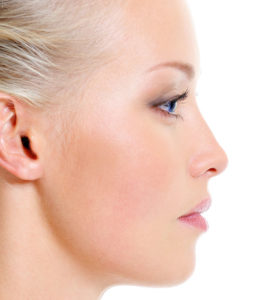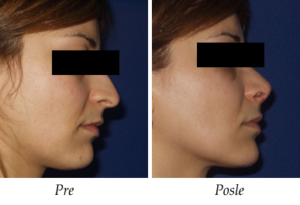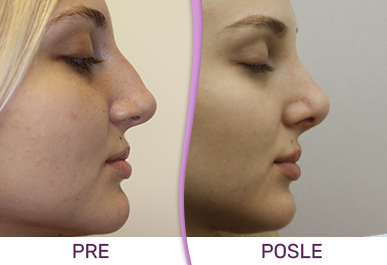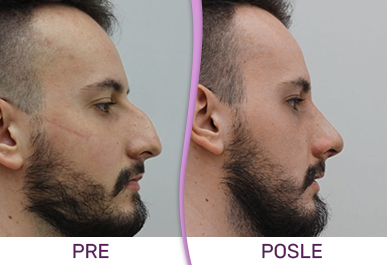Surgical Nose Correction – Rhinoplasty
Rhinoplasty is an operation that modifies the shape of your nose, the nose bone or cartilage.
The correction of the nose is one of the most frequent sought after plastic surgeries.

Are you a candidate for Rhinoplasty?
The candidates for Rhinoplasty are patients who wish to improve their nose after an injury, change and improve their breathing function, improve birth defects regarding nasal development, and are generally dissatisfied with the shape of their nose.
Changes that your surgeon can make to your nose through Rhinoplasty:
– Change the size of the nose
– straitening of the nose bridge
– changing/shaping the tip of nose
-narrowing of the nostrils
If the surgery is performed for aesthetic reasons, it is advised that the patient waits until the nasal bone has had a chance to fully develop. For females, this is around the age of 15, for males it may be much later. However, if surgery is needed to correct breathing problems, Rhinoplasty can be performed at a younger age.
What are the risks of Rhinoplasty?
All nose operations have a certain amount of risk involved, such as: infection, bleeding, or a negative reaction to the anesthesia. Rhinoplasty can also increase a risk of:
– Difficulty breathing
– bleeding from the nose
– Numbness of the nose
– asymmetrical nose
– scarring
How to prepare for a Rhinoplasty?

First one should meet with their surgeon in order to discuss whether or not you are an ideal candidate for the procedure. You and your surgeon will go over why you wish to have the procedure, and what your expectations are.
Your surgeon will go over your medical history and discuss whether you are using any current medication, and if you are currently suffering from any medical conditions.
The surgeon will perform a physical exam, and will carefully look over the skin surrounding and inside your nose in order to determine the changes that can be made. It may be advisable to perform a blood analysis and other laboratory exams as well.
This consultation will include the photographing of your nose from different angles. These photographs will be used to make an estimate of the long-term results that can be achieved, and they may be used during the procedure as well.
Advisory:
Smokers have a harder recovery process post Rhinoplasty, due to cigarettes having an adverse effect on the nasal mucosa. This is due to nicotine collecting in your blood vessels, which lowers the amount of oxygen, and blood supply to the tissues that need to recover. This is why quitting smoking before and after surgery is greatly benefits the healing process.
How does the procedure look like?
Your surgeon will use general anesthesia. However, if the procedure is less complex (such as a simple correction of the tip of the nose), you will receive local anesthesia.
The surgeon will make small incisions in a discrete location in the inside of the nose, or underneath the nose. This is where the surgeon will separate the skin from the cartilage or nose bone, then he will begin shaping your nose. If the surgeon requires more cartilage the surgeon will use some from deep inside your nose. If more is needed, you may get an implant or bone graft. The bone graft is an additional bone that is added to the bone within the nose.
Traditionally Rhinoplasty lasts anywhere between 2 to 3 hours. If the operation is more complicated it may last longer.
Recovery from Rhinoplasty
After the rhinoplasty surgery, the surgeon will place a thermoplastic mask on your nose. This will help the nose hold its shape while it recovers. Some nose swabs will be placed inside the nostril in order to stabilize the septum.
You will be underneath observation for a few hours post operation. If everything is in order you will be discharged the next day or even a little later on in the day after the surgery is done. If the surgery was complex, the patient will be required to stay in the hospital a little longer (a day or two).
In order to reduce the bleeding and swelling, it is required for you to rest with your head slightly elevated above your chest.
If your nose is swollen or if there are swabs inside to stop the bleeding, you may feel that your nose is congested. The splints placed on the nose are usually taken off a week after the operation. If you have absorbent seam in place, they will soon dissolve by themselves so removing them is not necessary. If they are not absorbent seams, you will need to pay your doctor a visit takes up to a week after surgery. If you have absorbing seams, it means that they will be dissolved and they will not need to be removed. If the seams are not absorbing, you will have to contact your doctor again one week after the surgery to remove the seams.
A few days after the nose correction you can experience secretion and bleeding from the nose. Usually a piece of gauze placed underneath your nose is used to absorb blood and mucus.
Consequently, you may get headaches, your face may be swollen and bloated (which are common occurrences). If this occurs your doctor will prescribe the appropriate pain relief medication.
After the operation has been completed, the patient should avoid the following activities for several weeks:
– running and other heavy physical activities
– swimming
– blowing your nose
– over chewing
– laughing or other facial expression that use many facial muscles.
– putting on any clothing covering their head/face
– wearing sunglasses
– rigorous teeth brushing.
Rhinoplasty may affect the region around the eyes, it may invoke stiffness, swelling or color change around the eyelids up to several weeks. In rare cases, this can last up to six weeks, with a small amount of swelling lasting longer. Cold packs can be placed in order to bring down the swelling and redness.
Your new nose will be visible after the bandages are removed in a period of 7 days.
After the operation, the patients can return to their usual activities after 1-2 weeks.
The Results of the Rhinoplasty
Even if Rhinoplasty is a relatively safe and simple procedure, the healing process may take some time. The tip of the nose is very sensitive, which is where you can feel some stiffness, and swelling for months. You may completely recover in several weeks, but some side effects may last for a few months.
- Can a rhinoplasty be combined with other procedures?
-
Absolutely! A rhinoplasty can be combined with almost any other procedure. Certain procedures can complement the results of rhinoplasty. For example, a chin implant or genioplasty can enhance the results of your procedure. Some patients prefer to have other unrelated procedures done at the same time to optimize their healing and recovery time.
- At what age is a rhinoplasty appropriate?
-
The ideal age for female patients is at least 16 years of age and older, and for male patients, 18 years of age and older. Before those ages, the nose and mid-face are still undergoing progressive growth.
- My nose correction was made but I am dissatisfied with the results. Can you do auditory rhinoplasty?
-
Yes, within the Atlas General Hospital, reoperations and secondary procedures are carried out. However, these interventions can sometimes be far more complicated than the first operation, and we advise you to schedule consultations with our doctor, which will determine if you are a suitable candidate for this procedure.
For more information and to schedule a consultation please call Atlas General Hospital at: +381 11 785 88 88.



